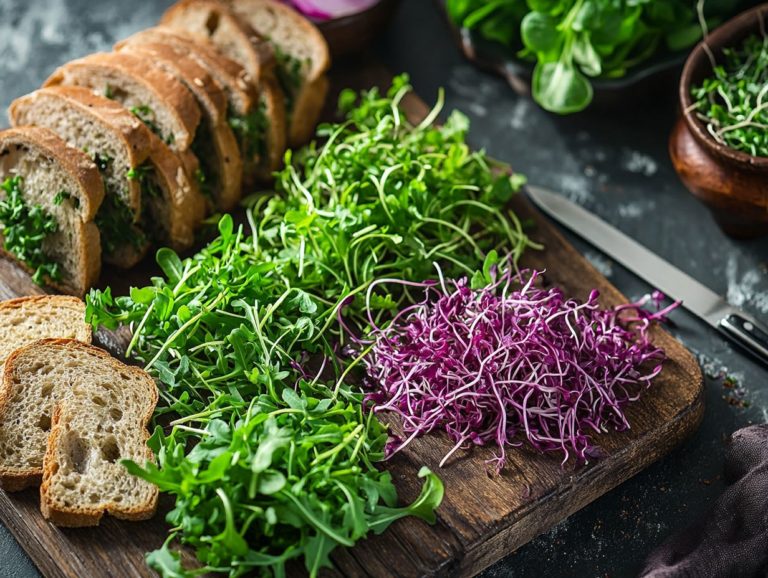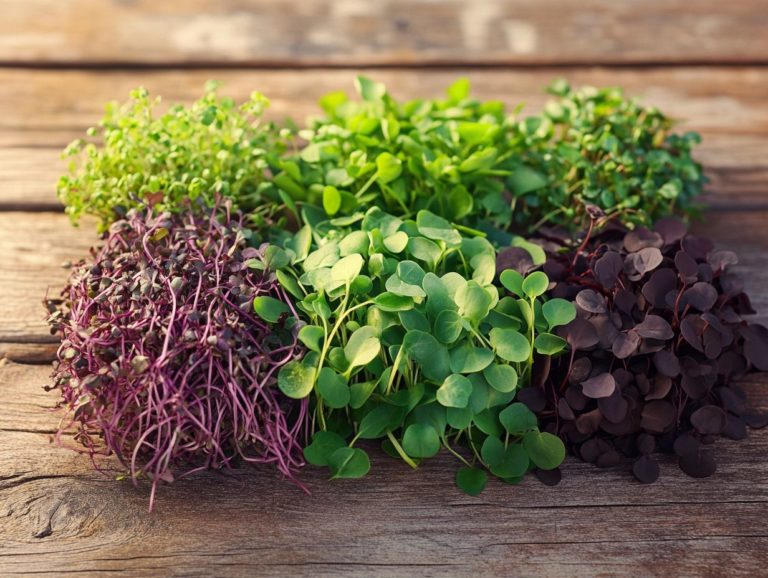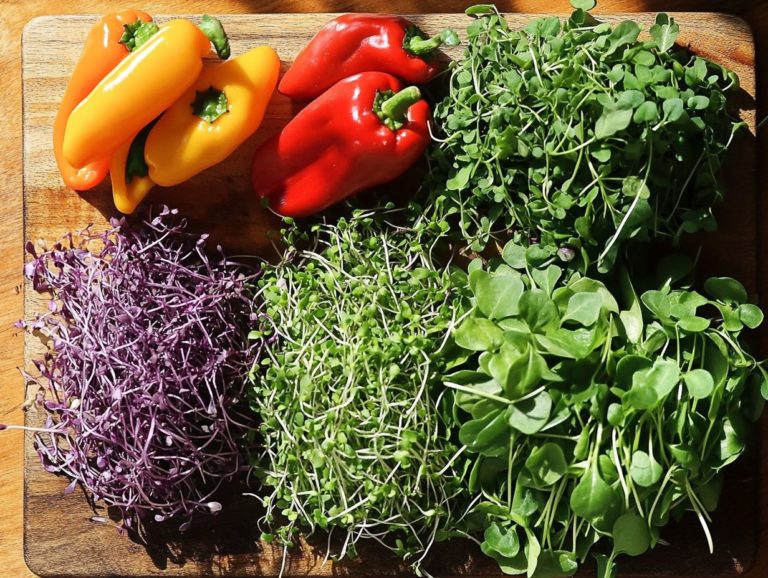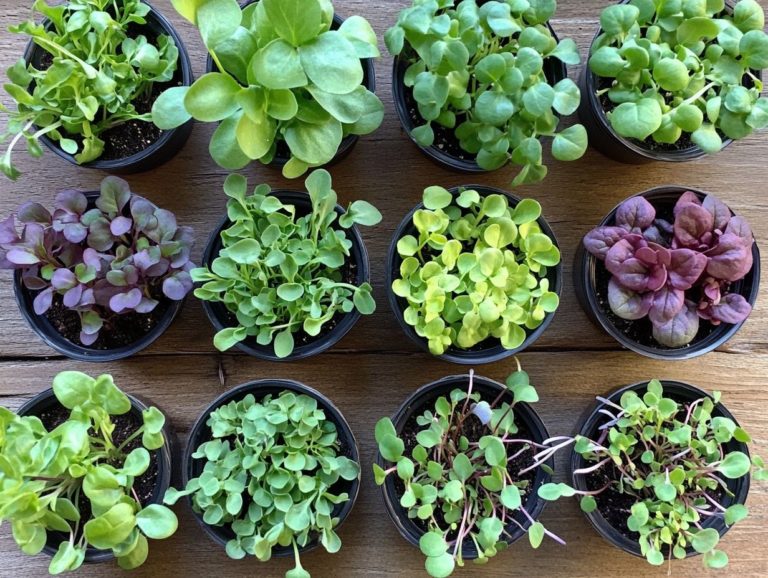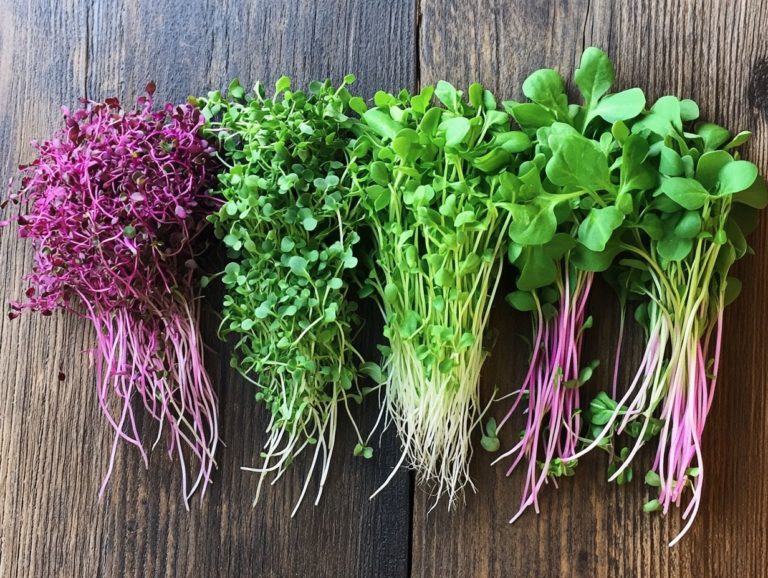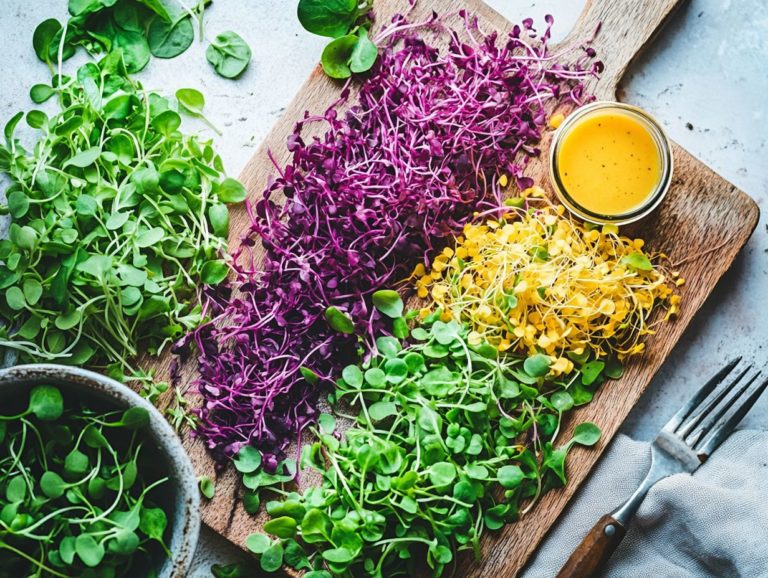How Microgreen Varieties Differ in Flavor
Microgreens have become a culinary sensation, celebrated not just for their vibrant colors but also for their complex flavors. Are you ready to explore the tantalizing world of microgreens? These tiny, nutrient-packed greens are more than just a garnish; they can elevate your dish and transform your palate into exciting flavors. Don t miss out on the chance to elevate your meals!
This article invites you to explore what microgreens are, the various types available, and the factors that influence their flavor. From growing conditions to harvesting techniques, you’ll discover how these elements shape the taste.
Delve into popular microgreens varieties like:
- Pea shoots
- Radish
- Arugula
Each offers unique profiles that can enhance your cooking with flavorful microgreens. Get ready to unlock the world of microgreens and find inspiration for your next culinary adventure!
Contents
- Key Takeaways:
- Understanding Microgreens
- Factors Affecting Flavor in Microgreens
- Frequently Asked Questions
- What are microgreen varieties and how do they differ in flavor?
- What are some common microgreen varieties and their flavor profiles?
- How do the growing conditions affect the flavor of microgreen varieties?
- Are there any microgreen varieties that are considered to be more flavorful than others?
- Do microgreen varieties differ in nutritional value and flavor?
- How can I incorporate different microgreen varieties into my cooking?
Key Takeaways:
- Microgreens may be small, but they pack a punch when it comes to flavor.
- The flavor of microgreens is greatly influenced by the growing conditions and harvesting techniques used.
- Each microgreen variety has its own unique flavor profile, with some varieties being spicy and others having a more mild taste.
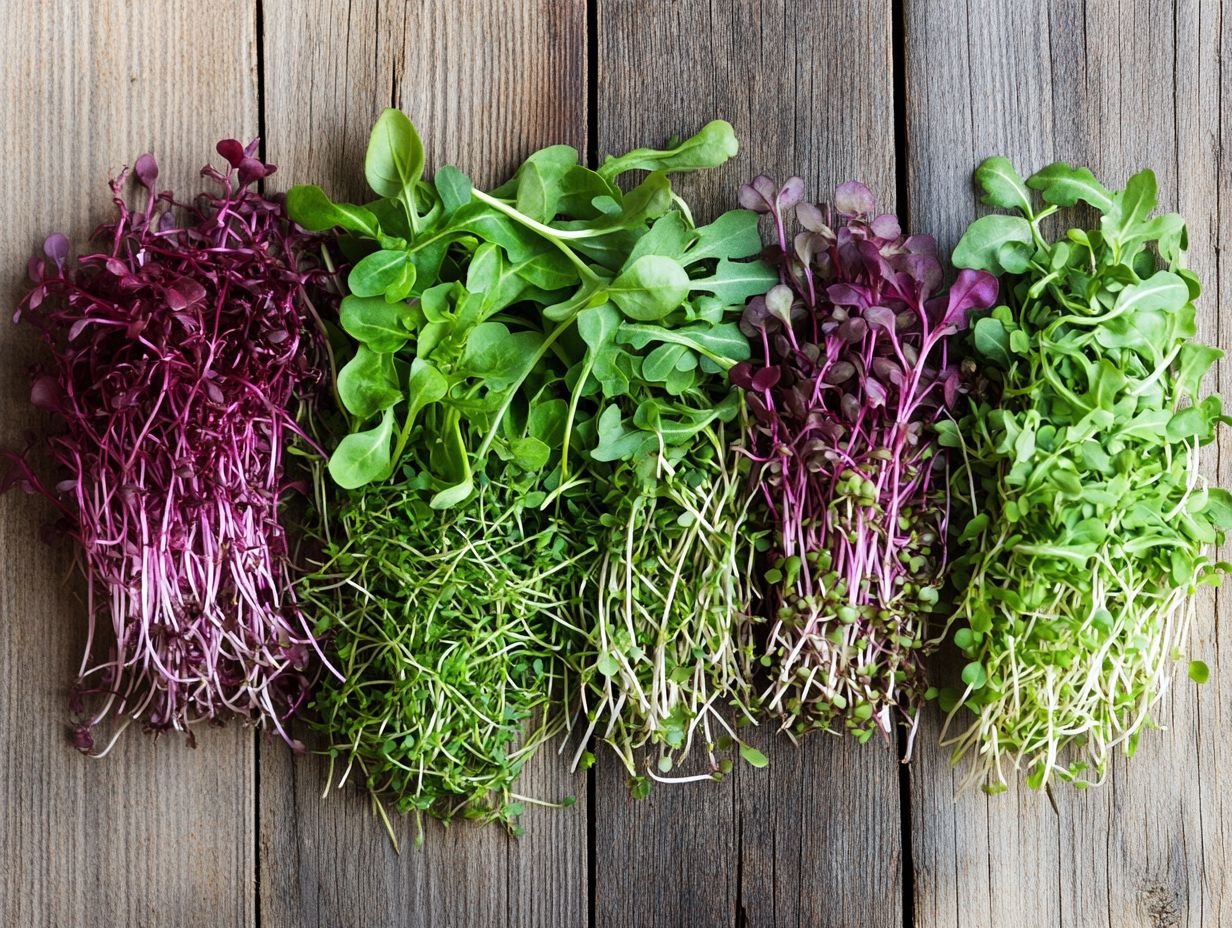
Understanding Microgreens
Understanding microgreens is crucial for anyone passionate about healthy eating and sustainable living, especially those eager to grow their own microgreens. These tiny yet nutrient-dense plants have truly revolutionized the home gardening scene and are perfect for homegrown greens.
Microgreens are young, edible plants harvested just after their first true leaves emerge, showering you with vibrant flavors, textures, and colors that make them incredibly versatile in the kitchen. Packed with rich nutritional benefits, including a high concentration of vitamins and minerals, they seamlessly integrate into any diet, whether you re cultivating them indoors or in small spaces using microgreen kits.
In this section, you’ll delve into the definition of microgreens, their various types, and the best growing techniques to unlock their full potential in your home garden.
Definition and Types of Microgreens
Microgreens are the hidden treasures in cooking, and you ll find that these young, edible plants, harvested at their tender stage, are bursting with flavor and packed with nutritional benefits. They re the perfect choice for anyone looking to elevate their home gardening experience.
These petite greens, typically harvested right after their first true leaves emerge, come in an array of types, offering a wonderful spectrum of flavors and colors, which can be enjoyed through various flavor combinations. Picture herb microgreens like basil and cilantro delivering fresh, vibrant tastes, while vegetable varieties such as radish and broccoli add a delightful crunch. For more ways to enhance flavor in microgreens, check out this helpful guide.
Rich in vitamins, minerals, and antioxidants, microgreens are your allies in boosting immunity and enhancing overall health, making them nutritious foods for any diet. They can be effortlessly sprinkled on salads, blended into smoothies, or used as a garnish for soups and sandwiches, making it easy for you to infuse nutritional value into your meals without sacrificing flavor.
Factors Affecting Flavor in Microgreens
The flavor profiles of microgreens can vary greatly depending on several factors, including growing conditions, harvesting techniques, and the specific microgreen varieties you select. It s essential for you to grasp these elements to achieve optimal results in your gardening endeavors.
Growing Conditions
The growing conditions of microgreens are pivotal in shaping their flavor, nutritional benefits, and overall health, especially when you’re cultivating them in compact spaces or through indoor gardening techniques using microgreen seeds.
To achieve optimal growth, these petite greens flourish in bright, indirect sunlight light that doesn t shine directly but illuminates the area for about 12 to 16 hours a day so a southern or eastern window is your best bet. Keeping the temperature between 65 F and 75 F can do wonders for their development. Opt for a lightweight, well-draining soil mix infused with organic matter to encourage robust root growth.
For fast-growing varieties like radish and mustard greens, it’s crucial to water them regularly without falling into the trap of waterlogging; achieving this moisture balance will help amplify their signature peppery flavors. Incorporating a diluted liquid fertilizer can enhance nutrient uptake, leading to a more flavorful harvest.
Start your microgreen journey today and transform your meals into vibrant, health-boosting dishes!
Harvesting Techniques

Harvesting techniques for microgreens are vital for getting the most out of their flavor and nutrition. These delicate plants retain their delightful crunch and vibrant hues, making them excellent salad garnishes.
To achieve the best results, pay close attention to the timing of your harvest. Typically, this is when the leaves are young and full of life, as this is when their flavors truly shine.
Utilizing the right tools, like sharp scissors or specialized microgreen harvesters, helps you make swift, clean cuts that minimize any damage to the plants. Handle the microgreens gently throughout the process to avoid bruising, which can compromise their quality.
Best practices dictate cutting at the soil line and promptly placing your freshly harvested greens in a cool, shaded area to maintain their freshness and crispness.
Popular Microgreen Varieties and Their Flavor Profiles
Discover a world of flavor with popular microgreen varieties! These greens can elevate your culinary creations and cater to every palate.
Pea Shoots
Pea shoots are a delightful variety of microgreens that you ll love for their sweet flavor and crunchy texture. They re a versatile ingredient in many dishes.
These tender greens, the young leaves and tendrils of the pea plant, offer a burst of freshness. They can elevate any culinary creation you whip up.
Packed with vitamins A, C, and K and essential minerals, pea shoots provide a nutritious boost to your meals. When you incorporate them into stir-fries, sandwiches, or even smoothies, they enhance both nutritional value and flavor.
Radish Microgreens
Radish microgreens are a true culinary gem, celebrated for their spicy flavor and striking color. They make a nutritious addition to salads, sandwiches, and various dishes.
These tiny greens dazzle the eyes and deliver an impressive array of health benefits. They include high levels of vitamins A, C, and E and essential minerals found in popular microgreens.
When grown in a bright, well-ventilated area, they flourish and can be harvested in just a couple of weeks. This makes them an excellent choice for urban gardeners and home cooks alike.
Sunflower Shoots
Sunflower shoots are celebrated for their mild flavor and delightful crunch. They re a versatile addition to salads, smoothies, and sandwiches, especially when looking for easy recipes.
These tender greens thrive in well-drained soil and soak up the sunlight, fostering delicate growth and maximizing nutrient retention. Enjoy them fresh to add a satisfying crunch to your dishes.
They serve as an excellent topping for grain bowls or tacos. With their subtle nutty undertones, sunflower shoots beautifully complement a variety of ingredients.
So, think of these shoots not just as a flavor booster but as a nourishing superfood that can elevate your meals while providing valuable health benefits.
Don’t miss out on trying these fresh ingredients in your next meal!
Broccoli Microgreens

Broccoli microgreens are a treasure trove of nutrients. They make a powerful addition to healthy dishes and are perfect for families seeking kid-friendly options.
With a mild, slightly peppery flavor, they elevate various meals. These tiny greens are packed with vitamins A, C, and K, along with antioxidants and anti-inflammatory properties that boost your wellness.
As a culinary enthusiast, you can easily add these microgreens to salads, sandwiches, or smoothies. For a quick tip: sprinkle them over scrambled eggs or avocado toast for an instant nutrient boost!
Arugula Microgreens
Arugula microgreens offer a distinct, peppery flavor. They are an excellent choice for salads and make delightful garnishes.
These petite greens are brimming with nutrients. They enhance the taste of dishes from sandwiches to soups.
Try adding them to pesto, sprinkling them on pizzas, or blending them into smoothies. They provide a satisfying crunch that pairs well with sweet ingredients like fruits or cheeses.
These microgreens are easy to grow in confined spaces. This makes them a great option for home chefs and urban gardeners.
And More…
In addition to well-known varieties, you will discover many microgreens with unique flavors. These can elevate your culinary experience.
Take spicy mustard microgreens, for example; they add a zesty kick to sandwiches. Beet microgreens lend a sweet, earthy note that brightens up any dish.
Pea shoots offer delightful sweetness and crunch, perfect for stir-fries or as a soup garnish. For a hint of citrus, try cilantro microgreens, which enhance tacos and salsas beautifully.
When growing these greens, remember to provide ample light and moisture. This simple care boosts their growth and flavor, allowing you to experiment with more recipes!
Frequently Asked Questions
What are microgreen varieties and how do they differ in flavor?
Microgreens are young plants harvested at the first stage of growth, usually within 7-14 days. They have distinct flavors based on their plant species and growing conditions.
What are some common microgreen varieties and their flavor profiles?
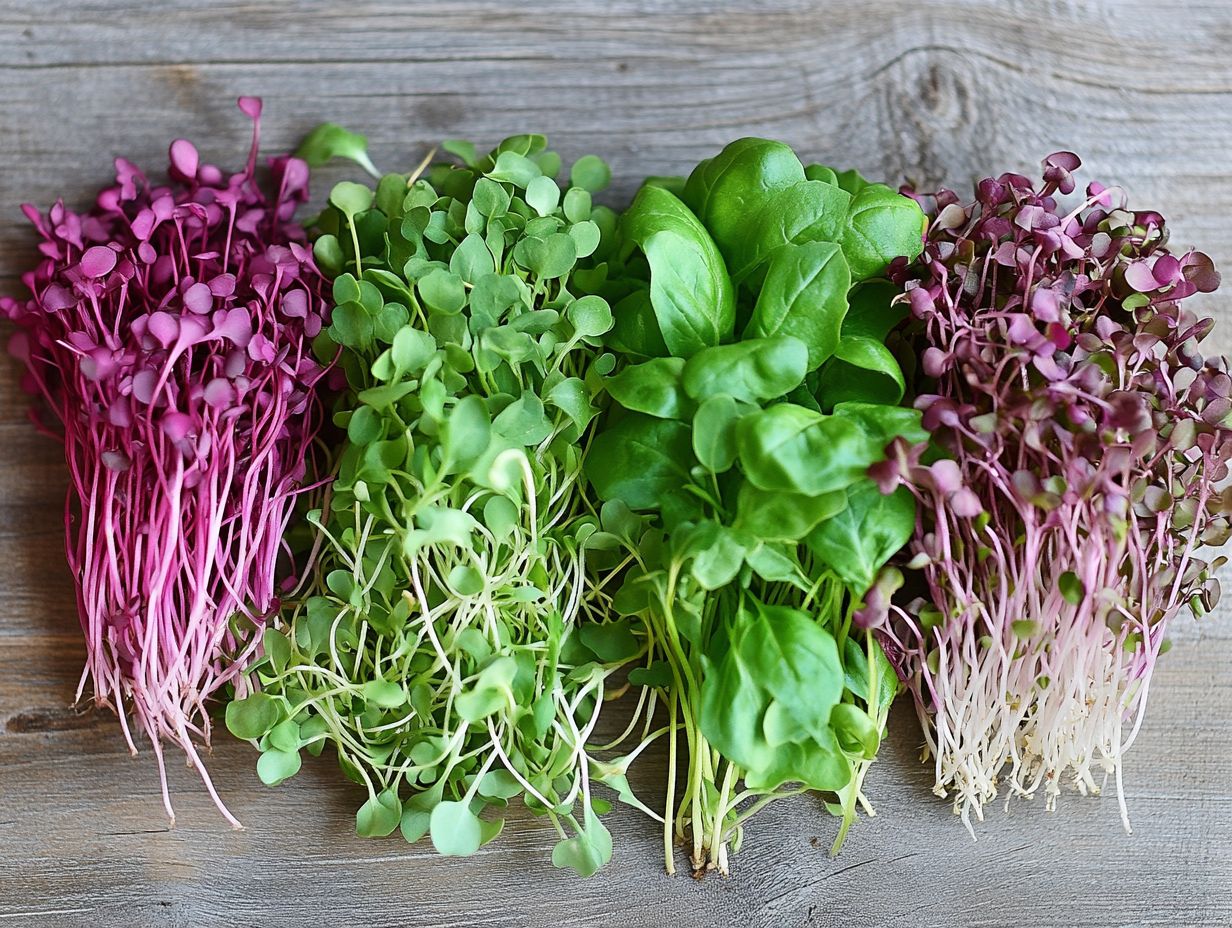
Popular microgreen varieties include broccoli, radish, sunflower, pea, and cilantro.
Broccoli microgreens have a mild, nutty taste. Radish microgreens offer a spicy, peppery flavor.
Sunflower microgreens are nutty and slightly sweet, while pea microgreens taste fresh and sweet.
Cilantro microgreens have a strong, pungent flavor and are a favored choice for beginners.
Herbs like basil and mustard bring exciting flavors to your dishes.
How do the growing conditions affect the flavor of microgreen varieties?
The flavor of microgreens can be impacted by factors such as the type of soil, the amount of light and moisture they receive, and the temperature.
For example, microgreens grown in nutrient-rich soil tend to have a more intense flavor compared to those grown in less fertile soil.
Utilizing methods for cultivating plants and understanding the process of seeds sprouting can also make a significant difference.
Are there any microgreen varieties that are considered to be more flavorful than others?
Some microgreens pack a punch with their bold flavors! For example, arugula microgreens have a bold and peppery taste, while basil microgreens have a sweet and slightly minty flavor.
It ultimately depends on personal preference and how the microgreens are used in dishes, making them a staple for culinary creations and offering exciting flavors to any meal.
Do microgreen varieties differ in nutritional value and flavor?
Yes, microgreens come with different nutrient levels. For instance, red cabbage microgreens are packed with vitamin C and vitamin K.
All microgreens are rich in vitamins, minerals, and antioxidants. They make a nutritious addition to meals!
How can I incorporate different microgreen varieties into my cooking?
Microgreens are versatile. Add them to salads, sandwiches, omelets, or soups for a flavor boost!
They also make excellent garnishes. Experimenting with different varieties can make meals exciting!
Consider trying a microgreen sample pack to discover your favorites!

